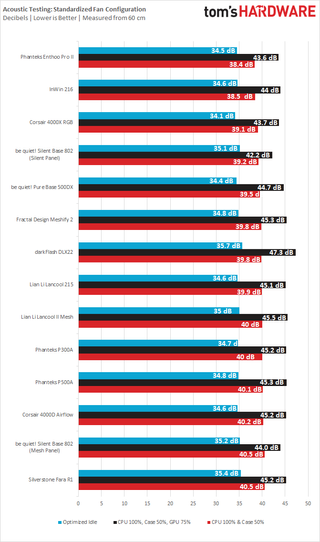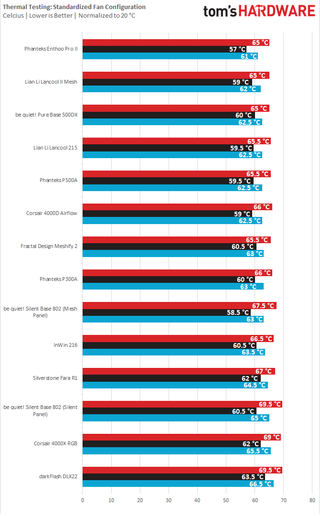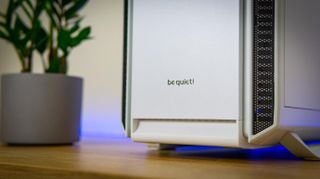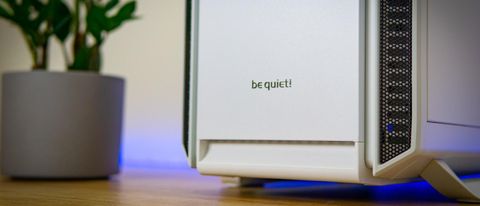Why you can trust Tom's Hardware
For thermal and acoustic testing, we are using the following software and settings:
| CPU Clock | i9 9900k: 4.6 GHz (46x 100MHz) @ 1.1v | Row 0 - Cell 2 |
| GPU Clock | RTX 2070 Super: Stock | Row 1 - Cell 2 |
| GPU Driver | Nvidia GeForce 445.87 | Row 2 - Cell 2 |
| Case & CPU Fan Speeds | 100% | Row 3 - Cell 2 |
| GPU Fan Speeds | 75% | Row 4 - Cell 2 |
Fan Characteristics
The three included 140mm Pure Winds 2 fans might not be top-tier spinners for be quiet!, but they do perform well. Their top speed I measured at about 1000 RPM, with the lowest speed they liked to spin at as low as 400 RPM. This is a perfectly adequate range.
Acoustic Results
For our acoustic tests, we run three scenarios: CPU full load, CPU and GPU full load, and an optimized idle. The CPU Full Load test runs the CPU and case fans at their maximum speed. For the CPU and GPU full load acoustic test we add the Nvidia RTX 2070 Super FE at 75% fan speed, because in practice it never runs at 100 percent and is far too loud when it does.
For the optimized idle, we run the GPU fan speed at 40 percent (the 2070 Super FE GPU does not have a Zero-RPM mode), and run the CPU and included case fans at the lowest speed they will spin at.

The noise floor in this room is measured as 34.0 dB during the day. Switch on the Silent Base 802 in the optimized idle scenario, and we get a reading of 34.3 dBA, which is among the quietest I’ve recorded yet. Bump the included fans and CPU fan up to max speed, and we once again get a very quiet chassis, but it’s when the loud RTX 2070 Super runs at 75 percent speed that we get the most impressive result, with a reading of 43.7 dBA. The other lowest reading is 44.7 achieved by the be quiet! Pure Base 500DX, which is notably louder. Most of the noise from the GPU was also that which bounced off the wall behind the chassis, so place it under your desk and you’ll notice it far less.
Putting the mesh panelling on led to a lot more noise coming through the front and top of the chassis, with the RTX 2070 Super being much more intrusive, subjectively, despite the 0.8 – 1.0 dB increase in noise level.
This chassis is also especially good at damping HDD noise compared to open cases.
Thermal Results
For the thermal tests, all case and CPU fan speeds are set to 100 percent. The i9-9900K is pegged at a 4.6GHz clock at 1.1v on all cores to ensure consistent power consumption across test scenarios, and letting the GPU run at 75 percent fan speed enables it to maintain its power target while maintaining one set reasonable fan speed, so that the temperature is the only variable.

Thermally, the Silent Base 802 performs surprisingly well, for a silence-optimized chassis. The included fans don’t let it run very loud, but despite that, its thermals are more than acceptable with the dampened front panel, and switching to the mesh panel makes it offer up almost chart-leading thermals with an improvement of about 3 °C. That’s not a huge thermal penalty for the dampened front panel though, especially given the improvement in acoustics, so I know which option I would choose to use every day.
Standardized Results
To correct for differences in case fans, for the standardized test we remove the standard case fans and replace them with Corsair ML120 or ML140 units. Up to three fans may be installed, preferably one at the default exhaust location and two at the front intake, in the biggest sizes the case supports. The above tests are then repeated, but because the Corsair ML fans have absurdly high maximum speeds, we run those at 50% duty for the tests, as no case fan should ever need to run above those speeds.


Subjecting the Silent Base 802 to our standardized suite, we find that the differences between it and other mesh cases are minimal in terms of thermals, albeit a little to the high side, with noise levels slightly higher too. We’re not sure why we recorded slightly higher noise levels, but we do have to note that the noise readings were, unusually, just shy of a dB higher than we normally, get, so we feel there is a bit of a deviation. We did replace the battery in our dB meter recently as the old one ran out, and although it shouldn’t, it is possible that it is responsible for the unusually-high reading.
Using the silent panel, the Silent Base 802 has among the higher thermals of the various cases we’ve tested, but they’re no cause for concern, and it’s among the quieter cases (despite the seemingly high dB reading).
Conclusion

With the Silent Base 802, be quiet! delivers a chassis that lives up to the company’s name. But in 2020 and 2021, mesh-intake cases seem to be on the rise, which is no surprise given the high TDP’s of Intel’s chips and Nvidia’s GPU. Because of this, in a way, it’s nice to see that be quiet! is including a mesh front panel and top cover for those seeking better thermal performance.
But, the thermal penalty for using the dampened front panel is about 3 degrees Celsius on both the CPU and GPU, which isn’t bad at all if you consider the 1 dB improvement in acoustics. 1 dB doesn’t sound like much, but trust me, it made a significant subjective difference. Because of this, I honestly question the inclusion of the mesh intake, as it essentially takes everything this case does right to keep the noise from leaking out and sticks a big, gaping hole in it – completely defeating the point of buying a silence-optimized chassis. If you’re buying this chassis with the intention of using the mesh as your main front panel: don’t – there are better mesh cases out there.
But if it’s silence you’re after, the Silent Base 802 offers impressive acoustics, paired with more-than-adequate thermal performance. It’s also extremely pleasant chassis to work with as it has tons of room for building, the panels come off easily, as do the filters for easy maintenance. As a case that sits under your desk and just does its job, this thing is brilliant. Whack the mesh on in summer if you don’t have AC and the thermals get out of control, and voila.
The only other things holding the 802 back from greatness are its steep price of $160 ($170 with tempered glass), the sheer size of the thing, and its outdated cable management system. That, and it’s a little inconvenient that the feet are so difficult to remove, because you’ll have to fight it to get it back in the box -- which you may want to do with your build if you need to move it to a new house or apartment at some point.
Also, if you’re in the market for a premium quiet case like this but with tempered glass, be quiet! has some stiff competition in its own lineup: I’d pony up the extra $10 to get the be quiet! Dark Base 700 instead, as that chassis offers more flexibility with the drive mounts, PWM fans, (non-addressable) RGB lighting, and actual brushed aluminum instead of painted steel – which all go a long way to making you feel like you get more for your money, even if it’s a hair more expensive. I like the Silent Base 802, but I’m not in love with it the way I am with the very-similar Dark Base 700.
MORE: Best Cases
MORE: All Case Content
Niels Broekhuijsen is a Contributing Writer for Tom's Hardware US. He reviews cases, water cooling and pc builds.

